The Refugee Convention: Examining Problems and Potential Amendments
VerifiedAdded on 2020/02/18
|7
|2615
|43
Essay
AI Summary
This essay provides a comprehensive overview of the 1951 Refugee Convention, examining its historical context, core principles, and the rights it grants to refugees. It delves into the convention's limitations in addressing contemporary issues of forced migration, such as the evolving causes of displacement, the rise of economic migration, and the challenges posed by internally displaced persons. The essay highlights specific problems, including the outdated definition of a refugee, the lack of provisions for internally displaced people, the uneven distribution of resources, and the complexities of the asylum-seeking process. Furthermore, it proposes and analyzes potential amendments to the convention, such as redefining the concept of a refugee to encompass a broader range of displacement causes, enhancing international cooperation, and improving the protection of internally displaced persons. The essay concludes by emphasizing the need for a modernized and globally inclusive approach to refugee protection, considering the current trends of globalization and the urgent need for more comprehensive and effective solutions.
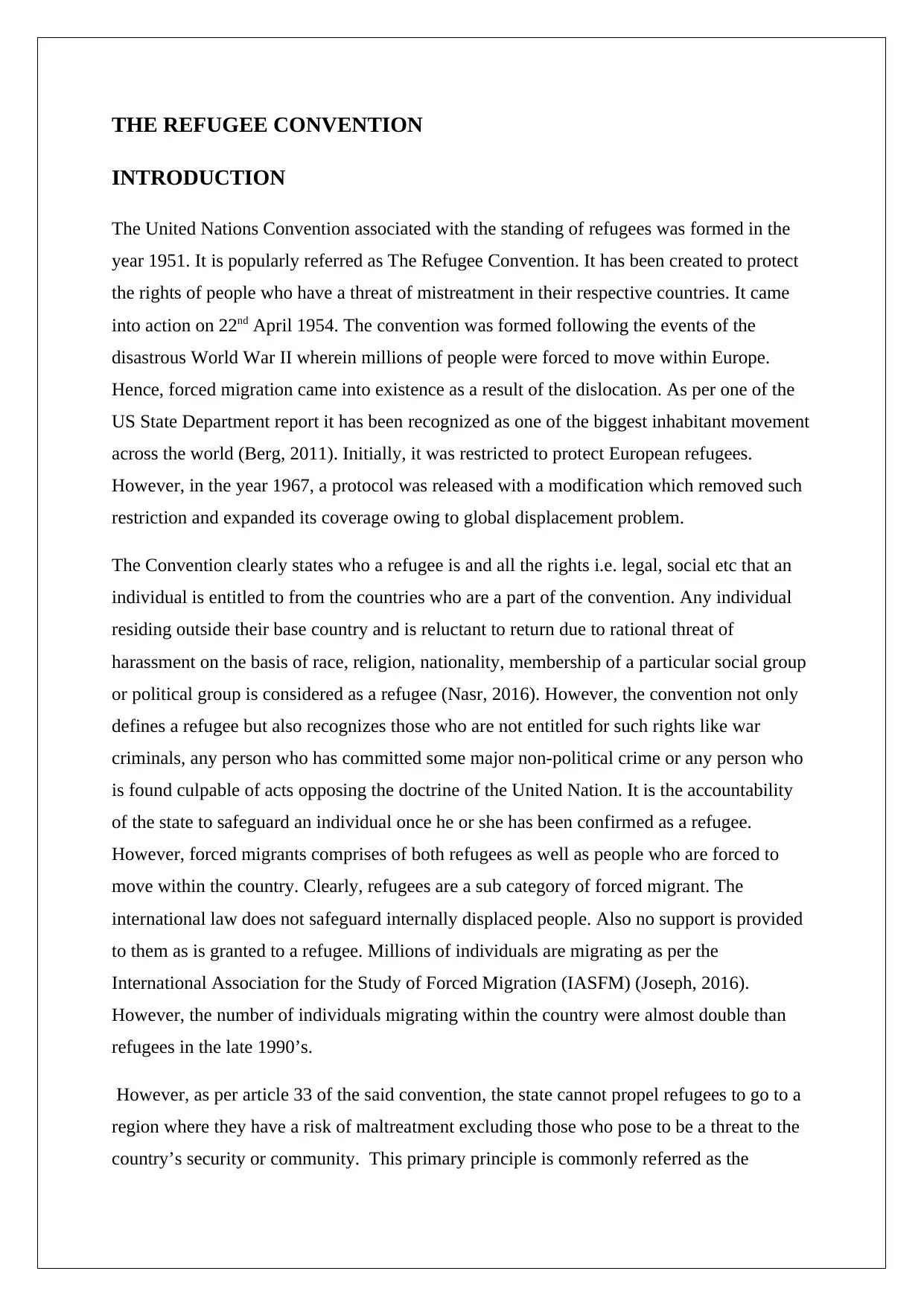
THE REFUGEE CONVENTION
INTRODUCTION
The United Nations Convention associated with the standing of refugees was formed in the
year 1951. It is popularly referred as The Refugee Convention. It has been created to protect
the rights of people who have a threat of mistreatment in their respective countries. It came
into action on 22nd April 1954. The convention was formed following the events of the
disastrous World War II wherein millions of people were forced to move within Europe.
Hence, forced migration came into existence as a result of the dislocation. As per one of the
US State Department report it has been recognized as one of the biggest inhabitant movement
across the world (Berg, 2011). Initially, it was restricted to protect European refugees.
However, in the year 1967, a protocol was released with a modification which removed such
restriction and expanded its coverage owing to global displacement problem.
The Convention clearly states who a refugee is and all the rights i.e. legal, social etc that an
individual is entitled to from the countries who are a part of the convention. Any individual
residing outside their base country and is reluctant to return due to rational threat of
harassment on the basis of race, religion, nationality, membership of a particular social group
or political group is considered as a refugee (Nasr, 2016). However, the convention not only
defines a refugee but also recognizes those who are not entitled for such rights like war
criminals, any person who has committed some major non-political crime or any person who
is found culpable of acts opposing the doctrine of the United Nation. It is the accountability
of the state to safeguard an individual once he or she has been confirmed as a refugee.
However, forced migrants comprises of both refugees as well as people who are forced to
move within the country. Clearly, refugees are a sub category of forced migrant. The
international law does not safeguard internally displaced people. Also no support is provided
to them as is granted to a refugee. Millions of individuals are migrating as per the
International Association for the Study of Forced Migration (IASFM) (Joseph, 2016).
However, the number of individuals migrating within the country were almost double than
refugees in the late 1990’s.
However, as per article 33 of the said convention, the state cannot propel refugees to go to a
region where they have a risk of maltreatment excluding those who pose to be a threat to the
country’s security or community. This primary principle is commonly referred as the
INTRODUCTION
The United Nations Convention associated with the standing of refugees was formed in the
year 1951. It is popularly referred as The Refugee Convention. It has been created to protect
the rights of people who have a threat of mistreatment in their respective countries. It came
into action on 22nd April 1954. The convention was formed following the events of the
disastrous World War II wherein millions of people were forced to move within Europe.
Hence, forced migration came into existence as a result of the dislocation. As per one of the
US State Department report it has been recognized as one of the biggest inhabitant movement
across the world (Berg, 2011). Initially, it was restricted to protect European refugees.
However, in the year 1967, a protocol was released with a modification which removed such
restriction and expanded its coverage owing to global displacement problem.
The Convention clearly states who a refugee is and all the rights i.e. legal, social etc that an
individual is entitled to from the countries who are a part of the convention. Any individual
residing outside their base country and is reluctant to return due to rational threat of
harassment on the basis of race, religion, nationality, membership of a particular social group
or political group is considered as a refugee (Nasr, 2016). However, the convention not only
defines a refugee but also recognizes those who are not entitled for such rights like war
criminals, any person who has committed some major non-political crime or any person who
is found culpable of acts opposing the doctrine of the United Nation. It is the accountability
of the state to safeguard an individual once he or she has been confirmed as a refugee.
However, forced migrants comprises of both refugees as well as people who are forced to
move within the country. Clearly, refugees are a sub category of forced migrant. The
international law does not safeguard internally displaced people. Also no support is provided
to them as is granted to a refugee. Millions of individuals are migrating as per the
International Association for the Study of Forced Migration (IASFM) (Joseph, 2016).
However, the number of individuals migrating within the country were almost double than
refugees in the late 1990’s.
However, as per article 33 of the said convention, the state cannot propel refugees to go to a
region where they have a risk of maltreatment excluding those who pose to be a threat to the
country’s security or community. This primary principle is commonly referred as the
Paraphrase This Document
Need a fresh take? Get an instant paraphrase of this document with our AI Paraphraser
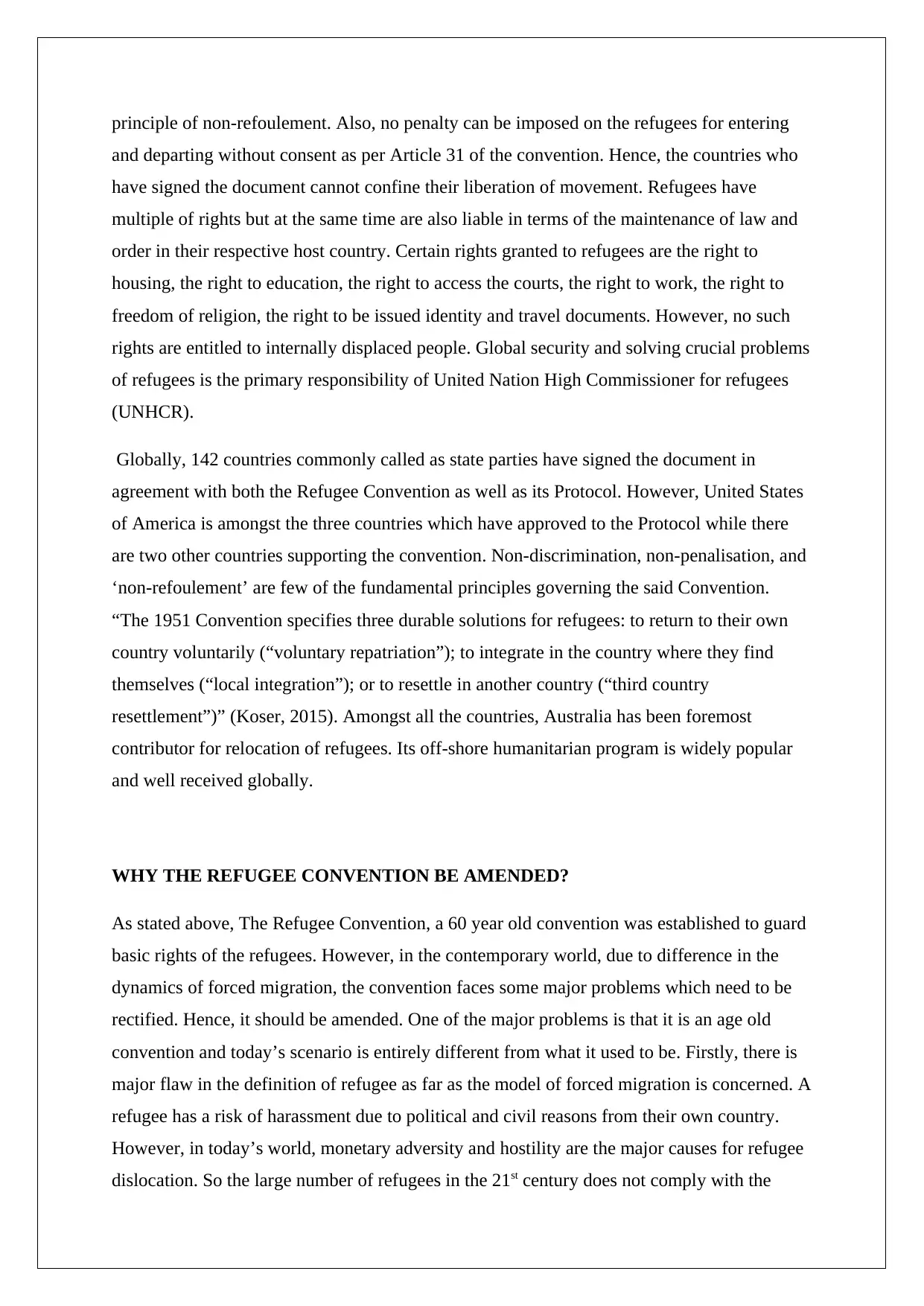
principle of non-refoulement. Also, no penalty can be imposed on the refugees for entering
and departing without consent as per Article 31 of the convention. Hence, the countries who
have signed the document cannot confine their liberation of movement. Refugees have
multiple of rights but at the same time are also liable in terms of the maintenance of law and
order in their respective host country. Certain rights granted to refugees are the right to
housing, the right to education, the right to access the courts, the right to work, the right to
freedom of religion, the right to be issued identity and travel documents. However, no such
rights are entitled to internally displaced people. Global security and solving crucial problems
of refugees is the primary responsibility of United Nation High Commissioner for refugees
(UNHCR).
Globally, 142 countries commonly called as state parties have signed the document in
agreement with both the Refugee Convention as well as its Protocol. However, United States
of America is amongst the three countries which have approved to the Protocol while there
are two other countries supporting the convention. Non-discrimination, non-penalisation, and
‘non-refoulement’ are few of the fundamental principles governing the said Convention.
“The 1951 Convention specifies three durable solutions for refugees: to return to their own
country voluntarily (“voluntary repatriation”); to integrate in the country where they find
themselves (“local integration”); or to resettle in another country (“third country
resettlement”)” (Koser, 2015). Amongst all the countries, Australia has been foremost
contributor for relocation of refugees. Its off-shore humanitarian program is widely popular
and well received globally.
WHY THE REFUGEE CONVENTION BE AMENDED?
As stated above, The Refugee Convention, a 60 year old convention was established to guard
basic rights of the refugees. However, in the contemporary world, due to difference in the
dynamics of forced migration, the convention faces some major problems which need to be
rectified. Hence, it should be amended. One of the major problems is that it is an age old
convention and today’s scenario is entirely different from what it used to be. Firstly, there is
major flaw in the definition of refugee as far as the model of forced migration is concerned. A
refugee has a risk of harassment due to political and civil reasons from their own country.
However, in today’s world, monetary adversity and hostility are the major causes for refugee
dislocation. So the large number of refugees in the 21st century does not comply with the
and departing without consent as per Article 31 of the convention. Hence, the countries who
have signed the document cannot confine their liberation of movement. Refugees have
multiple of rights but at the same time are also liable in terms of the maintenance of law and
order in their respective host country. Certain rights granted to refugees are the right to
housing, the right to education, the right to access the courts, the right to work, the right to
freedom of religion, the right to be issued identity and travel documents. However, no such
rights are entitled to internally displaced people. Global security and solving crucial problems
of refugees is the primary responsibility of United Nation High Commissioner for refugees
(UNHCR).
Globally, 142 countries commonly called as state parties have signed the document in
agreement with both the Refugee Convention as well as its Protocol. However, United States
of America is amongst the three countries which have approved to the Protocol while there
are two other countries supporting the convention. Non-discrimination, non-penalisation, and
‘non-refoulement’ are few of the fundamental principles governing the said Convention.
“The 1951 Convention specifies three durable solutions for refugees: to return to their own
country voluntarily (“voluntary repatriation”); to integrate in the country where they find
themselves (“local integration”); or to resettle in another country (“third country
resettlement”)” (Koser, 2015). Amongst all the countries, Australia has been foremost
contributor for relocation of refugees. Its off-shore humanitarian program is widely popular
and well received globally.
WHY THE REFUGEE CONVENTION BE AMENDED?
As stated above, The Refugee Convention, a 60 year old convention was established to guard
basic rights of the refugees. However, in the contemporary world, due to difference in the
dynamics of forced migration, the convention faces some major problems which need to be
rectified. Hence, it should be amended. One of the major problems is that it is an age old
convention and today’s scenario is entirely different from what it used to be. Firstly, there is
major flaw in the definition of refugee as far as the model of forced migration is concerned. A
refugee has a risk of harassment due to political and civil reasons from their own country.
However, in today’s world, monetary adversity and hostility are the major causes for refugee
dislocation. So the large number of refugees in the 21st century does not comply with the
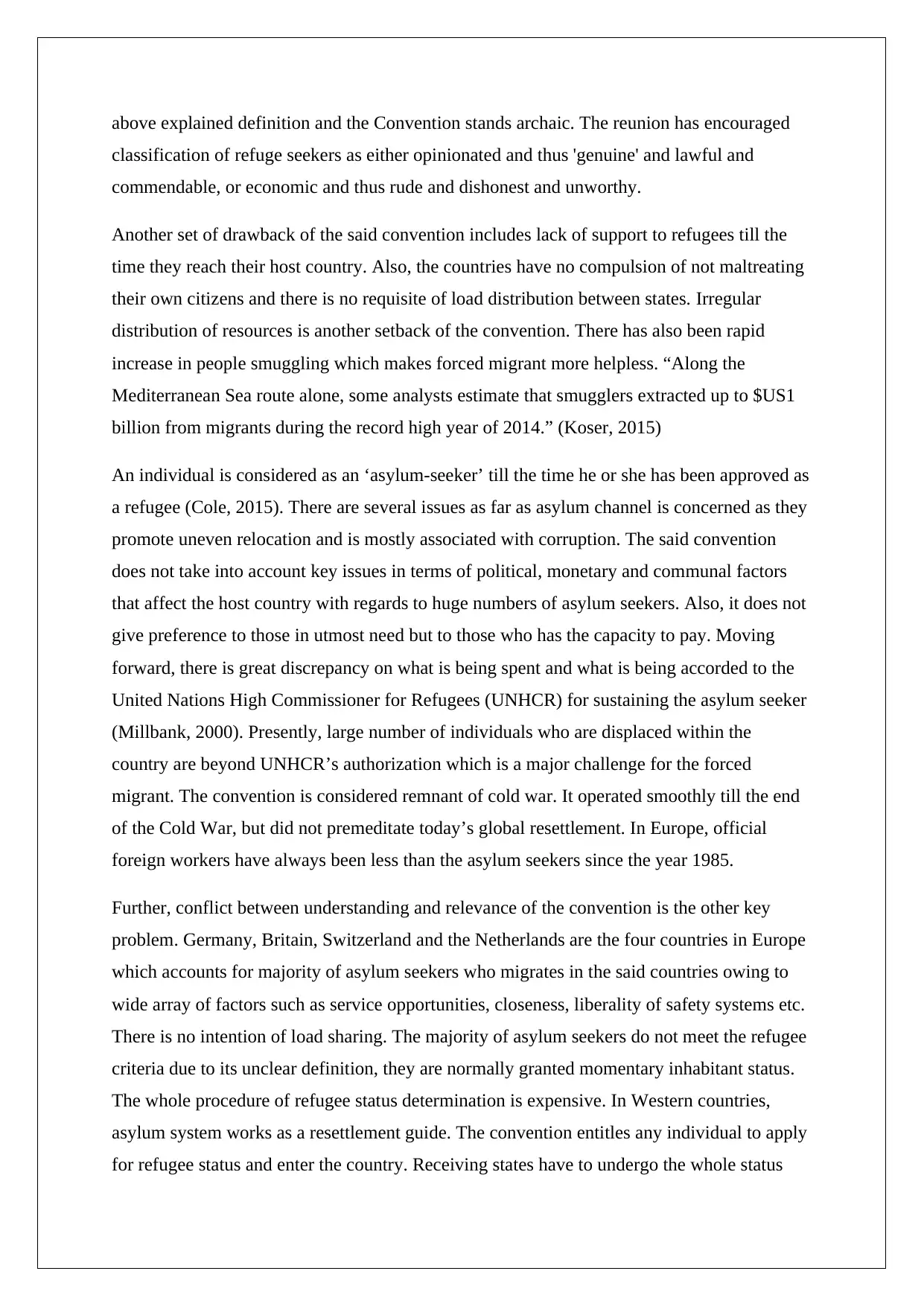
above explained definition and the Convention stands archaic. The reunion has encouraged
classification of refuge seekers as either opinionated and thus 'genuine' and lawful and
commendable, or economic and thus rude and dishonest and unworthy.
Another set of drawback of the said convention includes lack of support to refugees till the
time they reach their host country. Also, the countries have no compulsion of not maltreating
their own citizens and there is no requisite of load distribution between states. Irregular
distribution of resources is another setback of the convention. There has also been rapid
increase in people smuggling which makes forced migrant more helpless. “Along the
Mediterranean Sea route alone, some analysts estimate that smugglers extracted up to $US1
billion from migrants during the record high year of 2014.” (Koser, 2015)
An individual is considered as an ‘asylum-seeker’ till the time he or she has been approved as
a refugee (Cole, 2015). There are several issues as far as asylum channel is concerned as they
promote uneven relocation and is mostly associated with corruption. The said convention
does not take into account key issues in terms of political, monetary and communal factors
that affect the host country with regards to huge numbers of asylum seekers. Also, it does not
give preference to those in utmost need but to those who has the capacity to pay. Moving
forward, there is great discrepancy on what is being spent and what is being accorded to the
United Nations High Commissioner for Refugees (UNHCR) for sustaining the asylum seeker
(Millbank, 2000). Presently, large number of individuals who are displaced within the
country are beyond UNHCR’s authorization which is a major challenge for the forced
migrant. The convention is considered remnant of cold war. It operated smoothly till the end
of the Cold War, but did not premeditate today’s global resettlement. In Europe, official
foreign workers have always been less than the asylum seekers since the year 1985.
Further, conflict between understanding and relevance of the convention is the other key
problem. Germany, Britain, Switzerland and the Netherlands are the four countries in Europe
which accounts for majority of asylum seekers who migrates in the said countries owing to
wide array of factors such as service opportunities, closeness, liberality of safety systems etc.
There is no intention of load sharing. The majority of asylum seekers do not meet the refugee
criteria due to its unclear definition, they are normally granted momentary inhabitant status.
The whole procedure of refugee status determination is expensive. In Western countries,
asylum system works as a resettlement guide. The convention entitles any individual to apply
for refugee status and enter the country. Receiving states have to undergo the whole status
classification of refuge seekers as either opinionated and thus 'genuine' and lawful and
commendable, or economic and thus rude and dishonest and unworthy.
Another set of drawback of the said convention includes lack of support to refugees till the
time they reach their host country. Also, the countries have no compulsion of not maltreating
their own citizens and there is no requisite of load distribution between states. Irregular
distribution of resources is another setback of the convention. There has also been rapid
increase in people smuggling which makes forced migrant more helpless. “Along the
Mediterranean Sea route alone, some analysts estimate that smugglers extracted up to $US1
billion from migrants during the record high year of 2014.” (Koser, 2015)
An individual is considered as an ‘asylum-seeker’ till the time he or she has been approved as
a refugee (Cole, 2015). There are several issues as far as asylum channel is concerned as they
promote uneven relocation and is mostly associated with corruption. The said convention
does not take into account key issues in terms of political, monetary and communal factors
that affect the host country with regards to huge numbers of asylum seekers. Also, it does not
give preference to those in utmost need but to those who has the capacity to pay. Moving
forward, there is great discrepancy on what is being spent and what is being accorded to the
United Nations High Commissioner for Refugees (UNHCR) for sustaining the asylum seeker
(Millbank, 2000). Presently, large number of individuals who are displaced within the
country are beyond UNHCR’s authorization which is a major challenge for the forced
migrant. The convention is considered remnant of cold war. It operated smoothly till the end
of the Cold War, but did not premeditate today’s global resettlement. In Europe, official
foreign workers have always been less than the asylum seekers since the year 1985.
Further, conflict between understanding and relevance of the convention is the other key
problem. Germany, Britain, Switzerland and the Netherlands are the four countries in Europe
which accounts for majority of asylum seekers who migrates in the said countries owing to
wide array of factors such as service opportunities, closeness, liberality of safety systems etc.
There is no intention of load sharing. The majority of asylum seekers do not meet the refugee
criteria due to its unclear definition, they are normally granted momentary inhabitant status.
The whole procedure of refugee status determination is expensive. In Western countries,
asylum system works as a resettlement guide. The convention entitles any individual to apply
for refugee status and enter the country. Receiving states have to undergo the whole status
⊘ This is a preview!⊘
Do you want full access?
Subscribe today to unlock all pages.

Trusted by 1+ million students worldwide
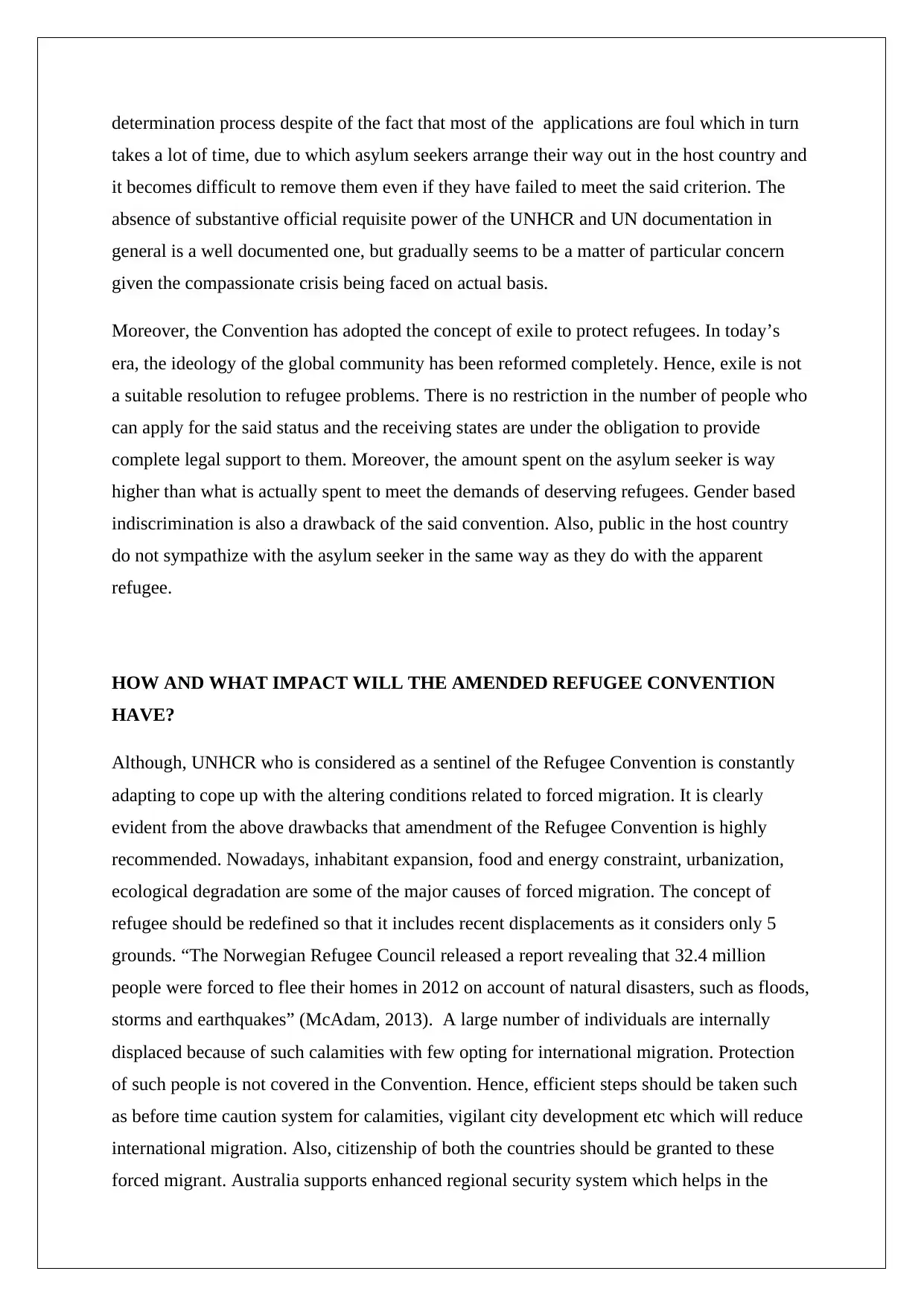
determination process despite of the fact that most of the applications are foul which in turn
takes a lot of time, due to which asylum seekers arrange their way out in the host country and
it becomes difficult to remove them even if they have failed to meet the said criterion. The
absence of substantive official requisite power of the UNHCR and UN documentation in
general is a well documented one, but gradually seems to be a matter of particular concern
given the compassionate crisis being faced on actual basis.
Moreover, the Convention has adopted the concept of exile to protect refugees. In today’s
era, the ideology of the global community has been reformed completely. Hence, exile is not
a suitable resolution to refugee problems. There is no restriction in the number of people who
can apply for the said status and the receiving states are under the obligation to provide
complete legal support to them. Moreover, the amount spent on the asylum seeker is way
higher than what is actually spent to meet the demands of deserving refugees. Gender based
indiscrimination is also a drawback of the said convention. Also, public in the host country
do not sympathize with the asylum seeker in the same way as they do with the apparent
refugee.
HOW AND WHAT IMPACT WILL THE AMENDED REFUGEE CONVENTION
HAVE?
Although, UNHCR who is considered as a sentinel of the Refugee Convention is constantly
adapting to cope up with the altering conditions related to forced migration. It is clearly
evident from the above drawbacks that amendment of the Refugee Convention is highly
recommended. Nowadays, inhabitant expansion, food and energy constraint, urbanization,
ecological degradation are some of the major causes of forced migration. The concept of
refugee should be redefined so that it includes recent displacements as it considers only 5
grounds. “The Norwegian Refugee Council released a report revealing that 32.4 million
people were forced to flee their homes in 2012 on account of natural disasters, such as floods,
storms and earthquakes” (McAdam, 2013). A large number of individuals are internally
displaced because of such calamities with few opting for international migration. Protection
of such people is not covered in the Convention. Hence, efficient steps should be taken such
as before time caution system for calamities, vigilant city development etc which will reduce
international migration. Also, citizenship of both the countries should be granted to these
forced migrant. Australia supports enhanced regional security system which helps in the
takes a lot of time, due to which asylum seekers arrange their way out in the host country and
it becomes difficult to remove them even if they have failed to meet the said criterion. The
absence of substantive official requisite power of the UNHCR and UN documentation in
general is a well documented one, but gradually seems to be a matter of particular concern
given the compassionate crisis being faced on actual basis.
Moreover, the Convention has adopted the concept of exile to protect refugees. In today’s
era, the ideology of the global community has been reformed completely. Hence, exile is not
a suitable resolution to refugee problems. There is no restriction in the number of people who
can apply for the said status and the receiving states are under the obligation to provide
complete legal support to them. Moreover, the amount spent on the asylum seeker is way
higher than what is actually spent to meet the demands of deserving refugees. Gender based
indiscrimination is also a drawback of the said convention. Also, public in the host country
do not sympathize with the asylum seeker in the same way as they do with the apparent
refugee.
HOW AND WHAT IMPACT WILL THE AMENDED REFUGEE CONVENTION
HAVE?
Although, UNHCR who is considered as a sentinel of the Refugee Convention is constantly
adapting to cope up with the altering conditions related to forced migration. It is clearly
evident from the above drawbacks that amendment of the Refugee Convention is highly
recommended. Nowadays, inhabitant expansion, food and energy constraint, urbanization,
ecological degradation are some of the major causes of forced migration. The concept of
refugee should be redefined so that it includes recent displacements as it considers only 5
grounds. “The Norwegian Refugee Council released a report revealing that 32.4 million
people were forced to flee their homes in 2012 on account of natural disasters, such as floods,
storms and earthquakes” (McAdam, 2013). A large number of individuals are internally
displaced because of such calamities with few opting for international migration. Protection
of such people is not covered in the Convention. Hence, efficient steps should be taken such
as before time caution system for calamities, vigilant city development etc which will reduce
international migration. Also, citizenship of both the countries should be granted to these
forced migrant. Australia supports enhanced regional security system which helps in the
Paraphrase This Document
Need a fresh take? Get an instant paraphrase of this document with our AI Paraphraser
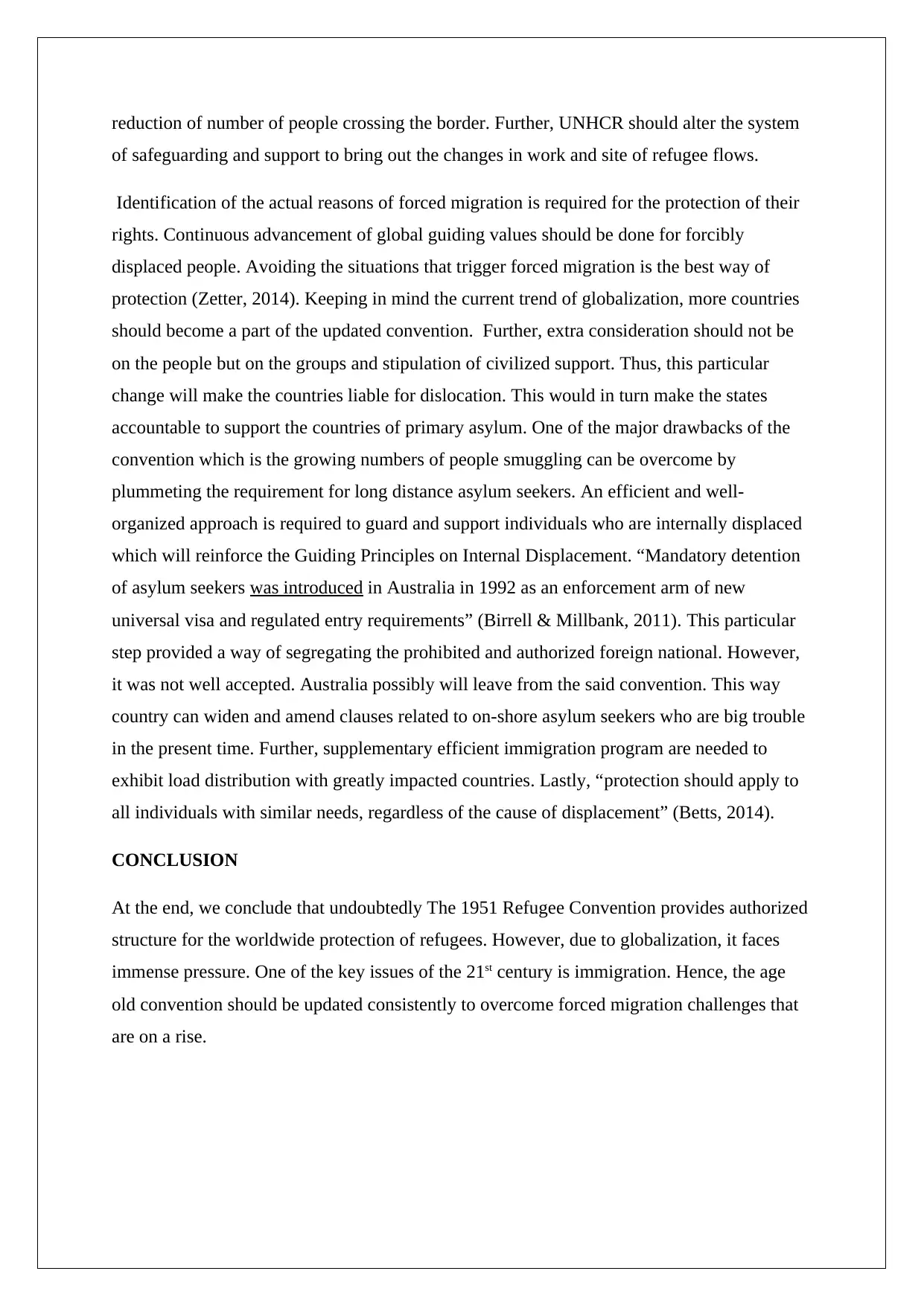
reduction of number of people crossing the border. Further, UNHCR should alter the system
of safeguarding and support to bring out the changes in work and site of refugee flows.
Identification of the actual reasons of forced migration is required for the protection of their
rights. Continuous advancement of global guiding values should be done for forcibly
displaced people. Avoiding the situations that trigger forced migration is the best way of
protection (Zetter, 2014). Keeping in mind the current trend of globalization, more countries
should become a part of the updated convention. Further, extra consideration should not be
on the people but on the groups and stipulation of civilized support. Thus, this particular
change will make the countries liable for dislocation. This would in turn make the states
accountable to support the countries of primary asylum. One of the major drawbacks of the
convention which is the growing numbers of people smuggling can be overcome by
plummeting the requirement for long distance asylum seekers. An efficient and well-
organized approach is required to guard and support individuals who are internally displaced
which will reinforce the Guiding Principles on Internal Displacement. “Mandatory detention
of asylum seekers was introduced in Australia in 1992 as an enforcement arm of new
universal visa and regulated entry requirements” (Birrell & Millbank, 2011). This particular
step provided a way of segregating the prohibited and authorized foreign national. However,
it was not well accepted. Australia possibly will leave from the said convention. This way
country can widen and amend clauses related to on-shore asylum seekers who are big trouble
in the present time. Further, supplementary efficient immigration program are needed to
exhibit load distribution with greatly impacted countries. Lastly, “protection should apply to
all individuals with similar needs, regardless of the cause of displacement” (Betts, 2014).
CONCLUSION
At the end, we conclude that undoubtedly The 1951 Refugee Convention provides authorized
structure for the worldwide protection of refugees. However, due to globalization, it faces
immense pressure. One of the key issues of the 21st century is immigration. Hence, the age
old convention should be updated consistently to overcome forced migration challenges that
are on a rise.
of safeguarding and support to bring out the changes in work and site of refugee flows.
Identification of the actual reasons of forced migration is required for the protection of their
rights. Continuous advancement of global guiding values should be done for forcibly
displaced people. Avoiding the situations that trigger forced migration is the best way of
protection (Zetter, 2014). Keeping in mind the current trend of globalization, more countries
should become a part of the updated convention. Further, extra consideration should not be
on the people but on the groups and stipulation of civilized support. Thus, this particular
change will make the countries liable for dislocation. This would in turn make the states
accountable to support the countries of primary asylum. One of the major drawbacks of the
convention which is the growing numbers of people smuggling can be overcome by
plummeting the requirement for long distance asylum seekers. An efficient and well-
organized approach is required to guard and support individuals who are internally displaced
which will reinforce the Guiding Principles on Internal Displacement. “Mandatory detention
of asylum seekers was introduced in Australia in 1992 as an enforcement arm of new
universal visa and regulated entry requirements” (Birrell & Millbank, 2011). This particular
step provided a way of segregating the prohibited and authorized foreign national. However,
it was not well accepted. Australia possibly will leave from the said convention. This way
country can widen and amend clauses related to on-shore asylum seekers who are big trouble
in the present time. Further, supplementary efficient immigration program are needed to
exhibit load distribution with greatly impacted countries. Lastly, “protection should apply to
all individuals with similar needs, regardless of the cause of displacement” (Betts, 2014).
CONCLUSION
At the end, we conclude that undoubtedly The 1951 Refugee Convention provides authorized
structure for the worldwide protection of refugees. However, due to globalization, it faces
immense pressure. One of the key issues of the 21st century is immigration. Hence, the age
old convention should be updated consistently to overcome forced migration challenges that
are on a rise.
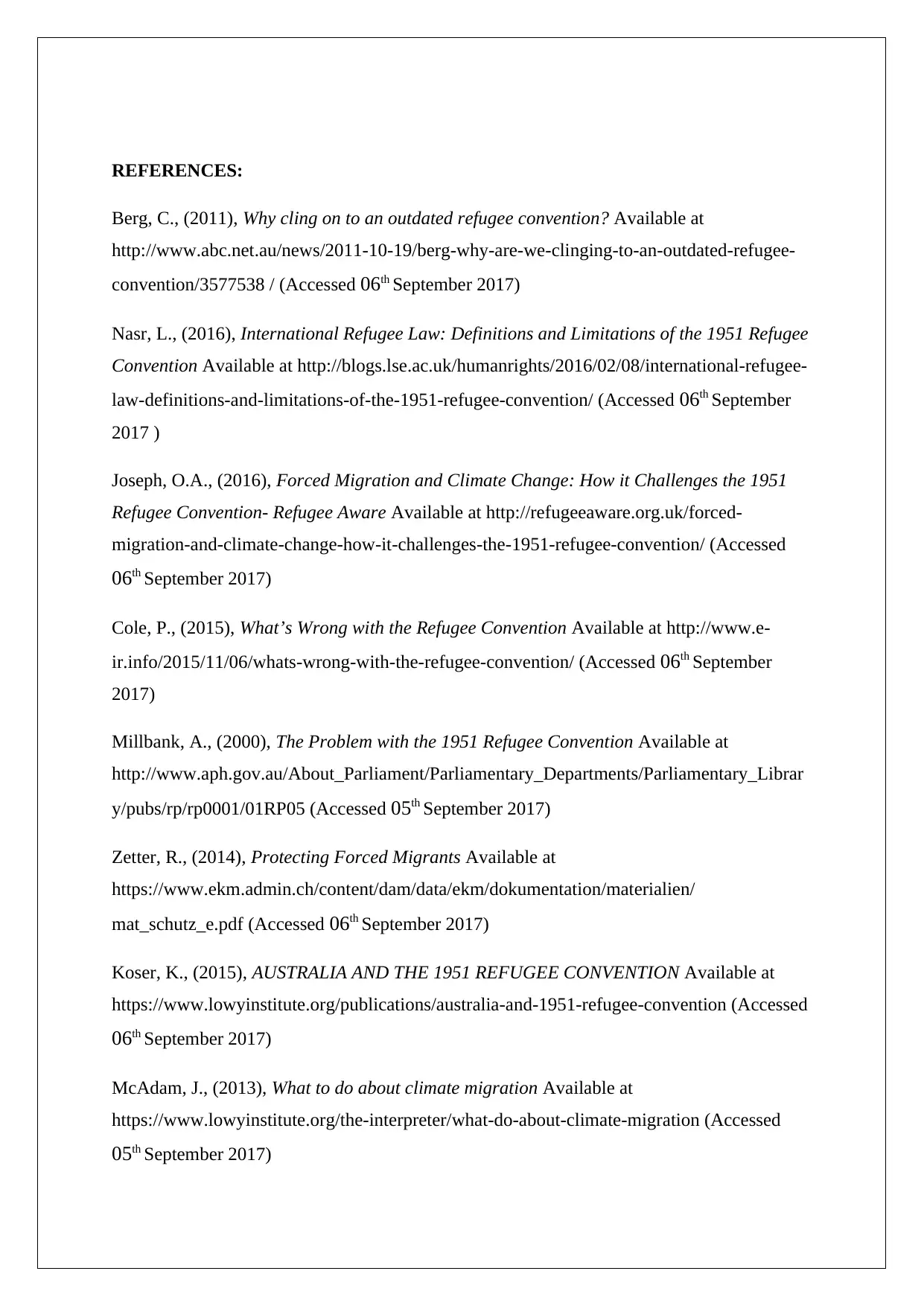
REFERENCES:
Berg, C., (2011), Why cling on to an outdated refugee convention? Available at
http://www.abc.net.au/news/2011-10-19/berg-why-are-we-clinging-to-an-outdated-refugee-
convention/3577538 / (Accessed 06th September 2017)
Nasr, L., (2016), International Refugee Law: Definitions and Limitations of the 1951 Refugee
Convention Available at http://blogs.lse.ac.uk/humanrights/2016/02/08/international-refugee-
law-definitions-and-limitations-of-the-1951-refugee-convention/ (Accessed 06th September
2017 )
Joseph, O.A., (2016), Forced Migration and Climate Change: How it Challenges the 1951
Refugee Convention- Refugee Aware Available at http://refugeeaware.org.uk/forced-
migration-and-climate-change-how-it-challenges-the-1951-refugee-convention/ (Accessed
06th September 2017)
Cole, P., (2015), What’s Wrong with the Refugee Convention Available at http://www.e-
ir.info/2015/11/06/whats-wrong-with-the-refugee-convention/ (Accessed 06th September
2017)
Millbank, A., (2000), The Problem with the 1951 Refugee Convention Available at
http://www.aph.gov.au/About_Parliament/Parliamentary_Departments/Parliamentary_Librar
y/pubs/rp/rp0001/01RP05 (Accessed 05th September 2017)
Zetter, R., (2014), Protecting Forced Migrants Available at
https://www.ekm.admin.ch/content/dam/data/ekm/dokumentation/materialien/
mat_schutz_e.pdf (Accessed 06th September 2017)
Koser, K., (2015), AUSTRALIA AND THE 1951 REFUGEE CONVENTION Available at
https://www.lowyinstitute.org/publications/australia-and-1951-refugee-convention (Accessed
06th September 2017)
McAdam, J., (2013), What to do about climate migration Available at
https://www.lowyinstitute.org/the-interpreter/what-do-about-climate-migration (Accessed
05th September 2017)
Berg, C., (2011), Why cling on to an outdated refugee convention? Available at
http://www.abc.net.au/news/2011-10-19/berg-why-are-we-clinging-to-an-outdated-refugee-
convention/3577538 / (Accessed 06th September 2017)
Nasr, L., (2016), International Refugee Law: Definitions and Limitations of the 1951 Refugee
Convention Available at http://blogs.lse.ac.uk/humanrights/2016/02/08/international-refugee-
law-definitions-and-limitations-of-the-1951-refugee-convention/ (Accessed 06th September
2017 )
Joseph, O.A., (2016), Forced Migration and Climate Change: How it Challenges the 1951
Refugee Convention- Refugee Aware Available at http://refugeeaware.org.uk/forced-
migration-and-climate-change-how-it-challenges-the-1951-refugee-convention/ (Accessed
06th September 2017)
Cole, P., (2015), What’s Wrong with the Refugee Convention Available at http://www.e-
ir.info/2015/11/06/whats-wrong-with-the-refugee-convention/ (Accessed 06th September
2017)
Millbank, A., (2000), The Problem with the 1951 Refugee Convention Available at
http://www.aph.gov.au/About_Parliament/Parliamentary_Departments/Parliamentary_Librar
y/pubs/rp/rp0001/01RP05 (Accessed 05th September 2017)
Zetter, R., (2014), Protecting Forced Migrants Available at
https://www.ekm.admin.ch/content/dam/data/ekm/dokumentation/materialien/
mat_schutz_e.pdf (Accessed 06th September 2017)
Koser, K., (2015), AUSTRALIA AND THE 1951 REFUGEE CONVENTION Available at
https://www.lowyinstitute.org/publications/australia-and-1951-refugee-convention (Accessed
06th September 2017)
McAdam, J., (2013), What to do about climate migration Available at
https://www.lowyinstitute.org/the-interpreter/what-do-about-climate-migration (Accessed
05th September 2017)
⊘ This is a preview!⊘
Do you want full access?
Subscribe today to unlock all pages.

Trusted by 1+ million students worldwide
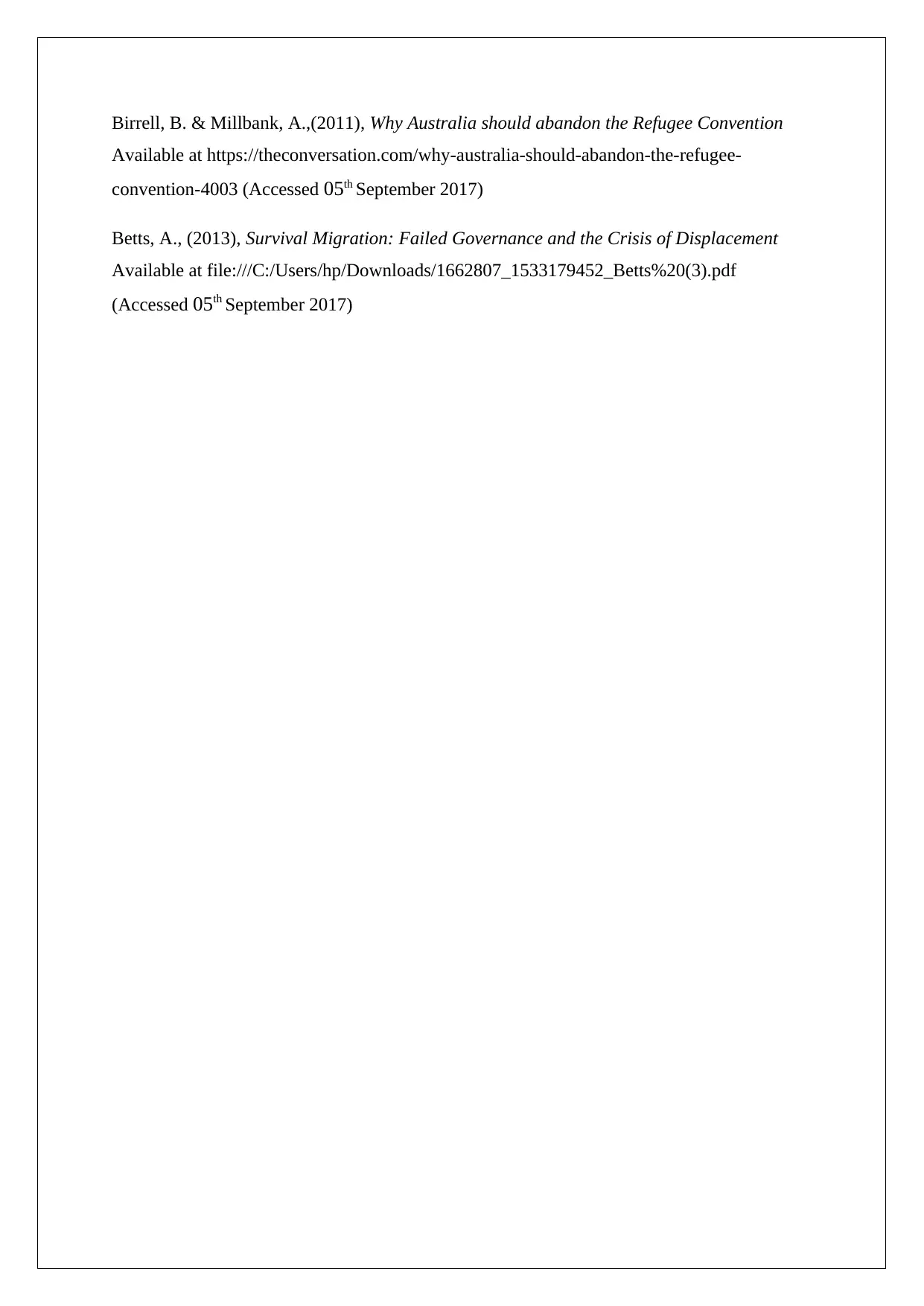
Birrell, B. & Millbank, A.,(2011), Why Australia should abandon the Refugee Convention
Available at https://theconversation.com/why-australia-should-abandon-the-refugee-
convention-4003 (Accessed 05th September 2017)
Betts, A., (2013), Survival Migration: Failed Governance and the Crisis of Displacement
Available at file:///C:/Users/hp/Downloads/1662807_1533179452_Betts%20(3).pdf
(Accessed 05th September 2017)
Available at https://theconversation.com/why-australia-should-abandon-the-refugee-
convention-4003 (Accessed 05th September 2017)
Betts, A., (2013), Survival Migration: Failed Governance and the Crisis of Displacement
Available at file:///C:/Users/hp/Downloads/1662807_1533179452_Betts%20(3).pdf
(Accessed 05th September 2017)
1 out of 7
Related Documents
Your All-in-One AI-Powered Toolkit for Academic Success.
+13062052269
info@desklib.com
Available 24*7 on WhatsApp / Email
![[object Object]](/_next/static/media/star-bottom.7253800d.svg)
Unlock your academic potential
Copyright © 2020–2025 A2Z Services. All Rights Reserved. Developed and managed by ZUCOL.





